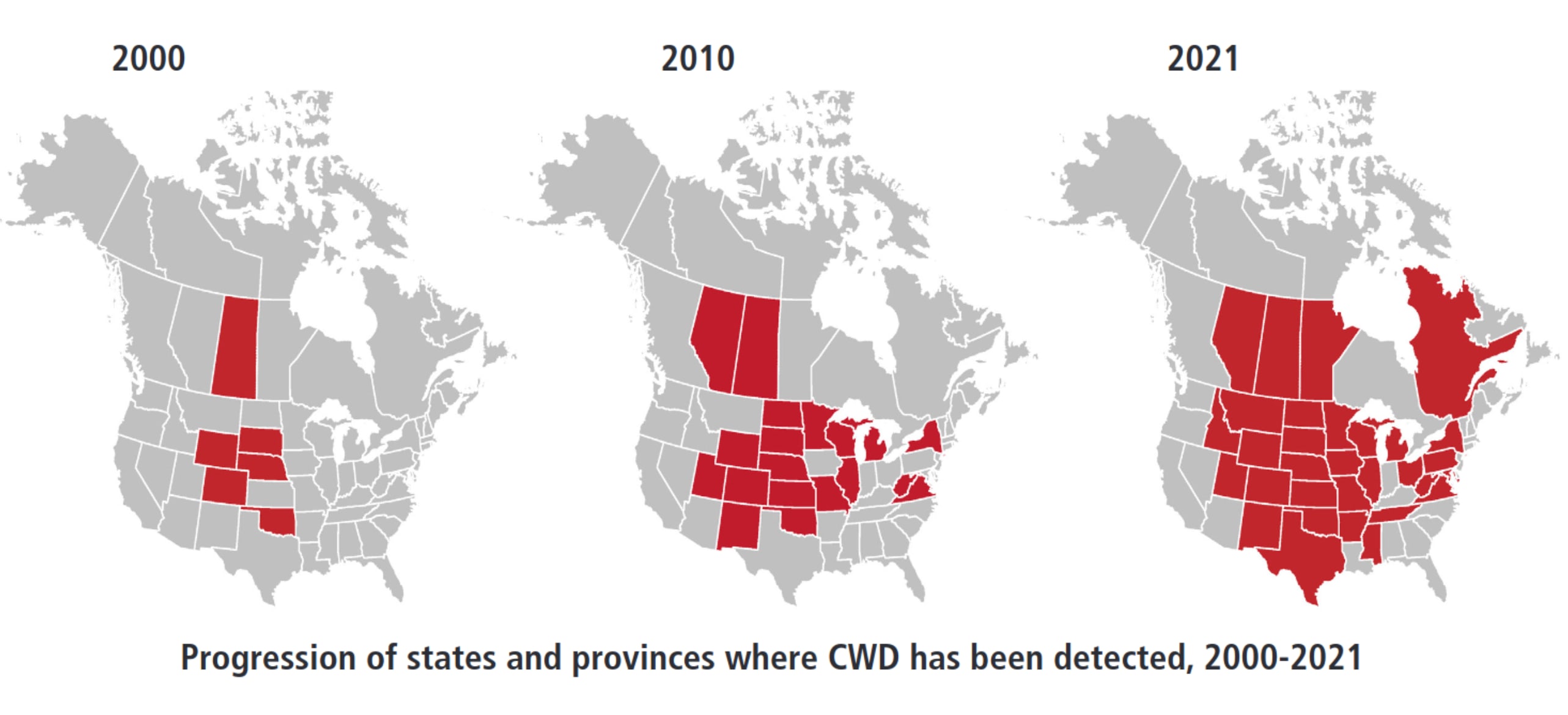Excerpt:
A novel lethal infectious neurological disease emerged in American deer a few decades ago. Since then, it’s spread rapidly across the continent. In areas where the disease is found, it can be very common in the deer there.

Chronic wasting disease isn’t caused by a bacteria, virus, protist, or worm – it’s a prion, which is a little misshapen version of a protein that occurs naturally in the nervous systems of deer.
Chemically, the prion is made of exactly the same stuff as its regular counterpart – it’s a string of the same amino acids in the same order, just shaped a little differently. Both the prion and its regular version (PrP) are monomers, single units that naturally stack on top of each other or very similar proteins. The prion’s trick is that as other PrP moves to stack atop it, the prion reshapes them – just a little – so that they also become prions. These chains of prions are quite stable, and, over time, they form long, persistent clusters in the tissue of their victims.
We know of only a few prion diseases in humans. They’re caused by random chance misfolds, a genetic predisposition for PrP to misfold into a prion, accidental cross-contamination via medical supplies, or, rarely, from the consumption of prion-infected meat. Every known animal prions is a misfold of the same specific protein, PrP. PrP is expressed in the nervous system, particularly in the brain – so infections cause neurological symptoms and physical changes to the structure of the brain. Prion diseases are slow to develop (up to decades), incurable, and always fatal.
There are two known infectious prion diseases in people. One is kuru, which caused an epidemic among tribes who practiced funerary cannibalism in Papua New Guinea. The other is mad cow disease, also known as bovine spongiform encephalopathy (BSE) AKA Variant Creutzfeldt-Jakob disease, which was first seen in humans in 1996 in the UK, and comes from cows.
Chronic wasting disease (CWD)…
- Is, like every other animal prion disease, a misfold of PrP. PrP is quite similar in both humans and deer.
- Is found in multiple deer species which are commonly eaten by humans.
- Can be carried in deer asymptomatically.
But it doesn’t seem to infect people. Is it ever going to? If a newly-emerged virus were sweeping across the US and killing deer, which could be spread through consuming infected meat, I would think “oh NO.” I’d need to see very good evidence to stop sounding the alarm.
Now, the fact that it’s been a few decades, and it hasn’t spread to humans yet, is definitely some kind of evidence about safety. But are we humans basically safe from it, or are we living on borrowed time? If you live in an area where CWD has been detected, should you eat the deer?
Sidenote: Usually, you’ll see “BSE” used for the disease in cows and “VCJ” for the disease in humans. But they’re caused by the same agent and this essay is operating under a zoonotic One Health kind of stance, so I’m just calling the disease BSE here. (As well as the prion that causes it, when I can get away with it.)
In short
The current version of CWD is not infectious to people. We checked. BSE showed that prions can spill over, and there’s no reason a new CWD variant will never do the same. The more cases there are, the more likely it is to spill over. That said, BSE did not spill over very effectively. It was always incredibly rare in humans. It’s an awful disease to get, but the chance of getting it is tiny. Prions in general have a harder time spilling over between species than viruses do. CWD might behave somewhat differently but probably will stay hampered by the species barrier.
Why do I think all of this? Keep reading.
Keep reading: Will the growing deer prion epidemic spread to humans? Why not? - Eukaryote Writes Blog
Or on LessWrong.

Thanks Eukaryote - I didn't know about this prion disease thanks for alerting me! The difference between this and other prion diseases appears to be that it can spread fairly readily through tissues that are not nervous tissues. That's why it is has managed to slowly spread and expand its geographic range
Both BSE and Kuru (as far as I know) spread only directly through ingestion of nervous system tissue. This makes them super easy to control, as you just (basically) have to make sure no animal or human eats brains and you are fine... That's why there have been so few human cases of any prion disease to date. I think the terror of these diseases capture the imagination due to its horrible progression and 100% mortality, more than a real large scale epidemic risk.
I'm unconcerned about this disease from a human suffering perspective, because I can't easily see a mechanism where this could become a quickly spreading, dangerous disease. Spreading to humans is possible isn't the biggest issue here I don't think. Even if humans somehow developed the condition - which is possible perhaps most likely only through direct handling of carcassas, despite continuing to eat hunted meat, I don't see a clear path could spread between humans in a sustained way".
All we have to do is avoid eating the body fluids of a human with the disease (which we do anyway) and it won't spread. There's no indication yet that prion diseases will find away to increase their infectivity.
I don't think we are living on borrowed time here, I'm not worried about this disease with fairly high confidence.
As a side note from an effective altruism animal suffering perspective this could be an important issue.